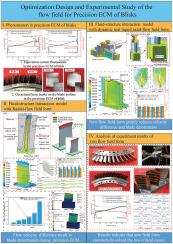Optimization design and experimental study of the flow field for precision ECM of blisks
IF 3.7
2区 工程技术
Q2 ENGINEERING, MANUFACTURING
Precision Engineering-Journal of the International Societies for Precision Engineering and Nanotechnology
Pub Date : 2025-06-06
DOI:10.1016/j.precisioneng.2025.05.022
引用次数: 0
Abstract
In the electrochemical machining (ECM) of the blisk, each blade must meet the machining requirements due to the blisk being an integral component. Therefore, maintaining the stability of the machining process is of great significance. However, in the current stage of the precision ECM process of blisks, it has been observed that blades may experience current fluctuation and occasional burn marks on the blade surface. In order to explore the causes of this phenomenon and solve the problem, this paper establishes a fluid-structure interaction mathematical model suitable for high-speed flow and geometric deformation during electrolytic precision machining. Meanwhile, a newly designed flow field and corresponding integrated fixture is proposed. Simulation results indicate that the new flow field successfully reduced the flow velocity difference between the concave and convex sides of the blade by 71 %, the equivalent stress on the blade decreased by 60 %, and blade deformation was reduced by 70 %. Meanwhile, corresponding experimental studies have been carried out. The experiment results show that the blade deformation decreased by 68 % with the new flow field form. 3D microscopic inspection and line roughness testing of the blade surface quality demonstrated that new flow field eliminated the current fluctuation and occasional burn marks phenomenon, and greatly enhanced the stability of the electrochemical fine machining process and the surface quality of the blades.

叶片精密电解加工流场优化设计与实验研究
在叶片的电化学加工中,由于叶片是一个整体部件,因此每个叶片都必须满足加工要求。因此,保持加工过程的稳定性具有重要意义。然而,在叶片精密ECM加工的当前阶段,已经观察到叶片可能会出现电流波动,并且叶片表面偶尔会出现烧伤痕迹。为了探究产生这一现象的原因并解决这一问题,本文建立了适用于电解精密加工过程中高速流动和几何变形的流固耦合数学模型。同时,提出了一种新的流场设计和相应的集成夹具。仿真结果表明,该流场成功地将叶片凹凸两侧的流速差减小了71%,叶片上的等效应力减小了60%,叶片变形减小了70%。同时,进行了相应的实验研究。实验结果表明,采用新型流场形式后,叶片变形减小了68%。叶片表面质量的三维显微检测和线条粗糙度测试表明,新流场消除了电流波动和偶尔的烧痕现象,大大提高了电化学精细加工过程的稳定性和叶片表面质量。
本文章由计算机程序翻译,如有差异,请以英文原文为准。
求助全文
约1分钟内获得全文
求助全文
来源期刊
CiteScore
7.40
自引率
5.60%
发文量
177
审稿时长
46 days
期刊介绍:
Precision Engineering - Journal of the International Societies for Precision Engineering and Nanotechnology is devoted to the multidisciplinary study and practice of high accuracy engineering, metrology, and manufacturing. The journal takes an integrated approach to all subjects related to research, design, manufacture, performance validation, and application of high precision machines, instruments, and components, including fundamental and applied research and development in manufacturing processes, fabrication technology, and advanced measurement science. The scope includes precision-engineered systems and supporting metrology over the full range of length scales, from atom-based nanotechnology and advanced lithographic technology to large-scale systems, including optical and radio telescopes and macrometrology.

 求助内容:
求助内容: 应助结果提醒方式:
应助结果提醒方式:


